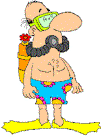Search Dive Sites
| Countries |
|
| Seas |
|

Share your knowledge...
 Indonesia Indian Ocean
Indonesia Indian OceanYou can either do a shore dive to this site or take a day boat for diving on the wall(a 5 minute swim from shore will get you to the reef). It is a good site for instruction as there is a flat bottom lagoon. There are Napoleon Wrasse and Dogtooth Tuna as well as schools. Lots of colourful coral and macro subjects.
more info about Amed, Bali including maps, reviews, and ratings...













 Thailand Andaman Sea
Thailand Andaman SeaShark Point is part of a Marine Sanctuary that was created in 1992, where there is no commercial fishing, and collecting marine life is forbidden. You will find a reef teaming with life, and a sandy bottom where leopard sharks often rest. It is very colourful, with schools of tropical fish, sea fans and soft corals covering the rock. It can be hard work finning with a quite brisk current, but they do tend to run parallel to the reef. A good photograhic dive.
more info about Shark Point , Phuket including maps, reviews, and ratings...














 Thailand Andaman Sea
Thailand Andaman SeaThe dive site is a huge pinnacle that starts at its peak just below the surface and then decends some 30m. It took about an hour to reach by boat, but was well worth the wait. We saw sea anemones as far as the eye could see that looked like huge fields swaying in the breeze. There are plenty of fish to photograph, including tuna, barracuda, tropical and clown fish and an abundance of lion fish. Although we did not see any we were told that you could find leopard shark here.
more info about Anemone Reef, Phuket including maps, reviews, and ratings...















 Fiji Pacific
Fiji PacificFiji is known for it's huge sea fans and soft corals, along with mantas, hammerheads and big pelagics. The diving is for all levels with shallow and deep reefs, ledges, wall diving, lagoons and wrecks. Dive sites are the Great White Wall, Purple and Red Wall, Yellow Wall, Rainbow Reef and the Pinnacle. At Beqa you will find a reef-filled lagoon with it's outer reefs having drop-offs that can plunge up to a mile down bringing in sharks and pelagics. Diving is all year, although there is normally a plankton bloom from February thro March. The water here is warm, but a lightweight wetsuit or lycra suit will give protection from abrasion etc.
more info about Great White Wall including maps, reviews, and ratings...


















 Papua New Guinea Pacific
Papua New Guinea PacificThe reefs here are still pretty pristine, and hard and soft corals are numerous in the lagoons, and around the islands and reefs. There is diving for every level of experience, deep reefs, shallow coral gardens, walls and of course WWII wrecks. The main diving areas are Madang for coral and Hansa Bay where you will encounter many shallow wrecks. Tufi has the fjords of Cape Nelson and Wlindi has sone of the most spectacular pinnacle and reef diving. There are also many live-aboard boats that visit the Islands and coral atolls. A lightweight wetsuit or lycra suit is advisable as protection from abrasion etc. The wet season is from December - April but diving is all year round.
more info about Papua New Guinea including maps, reviews, and ratings...


















 Solomon islands Pacific
Solomon islands PacificThere is diving for every level here, with reef and wall diving along with numerous wrecks. There is endless opportunities for the underwater photographer. Brilliant soft corals, huge sea fans and hard corals, along with turtles, shoals, manta rays and the occassional hammerhead.
Wrecks are most prolific on the seabed in Guadalcanal, and Gizo also has many wrecks. The wet season here is November to April when severe storms can arrive, but diving is available all year round although the best time is from April - October.
For protection against sharp coral etc. a lightweight wetsuit or lycra suit is advised.
more info about Solomon Islands including maps, reviews, and ratings...













